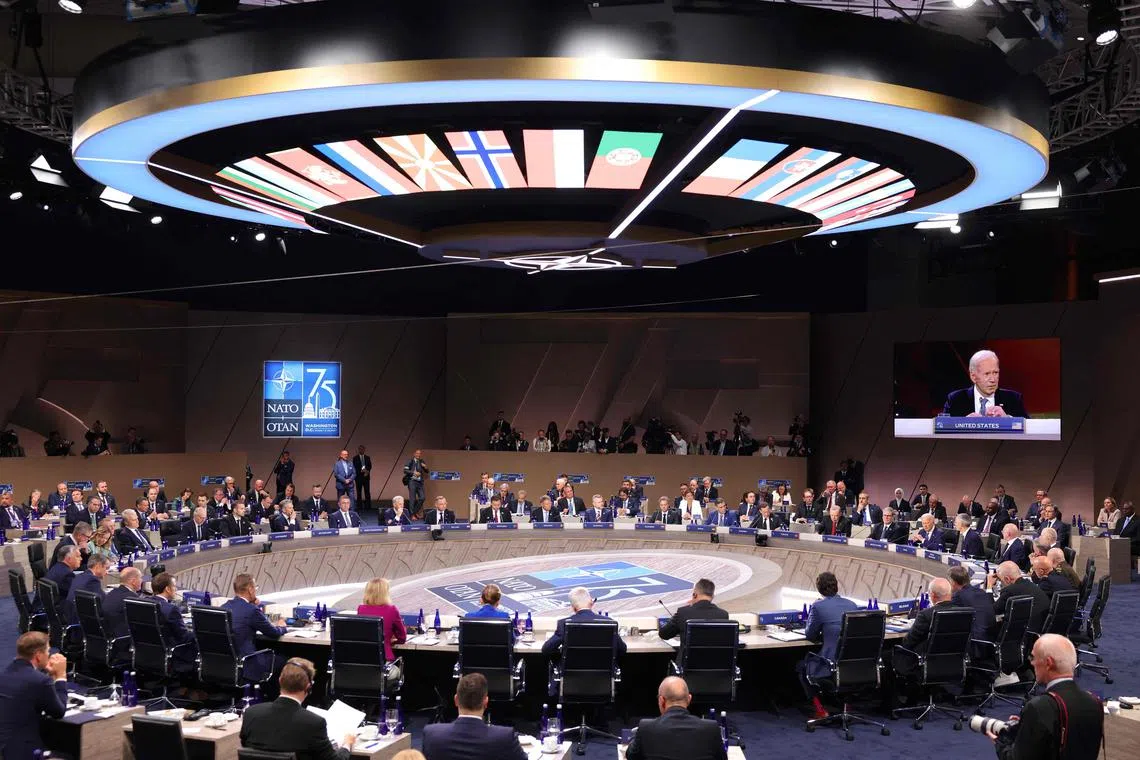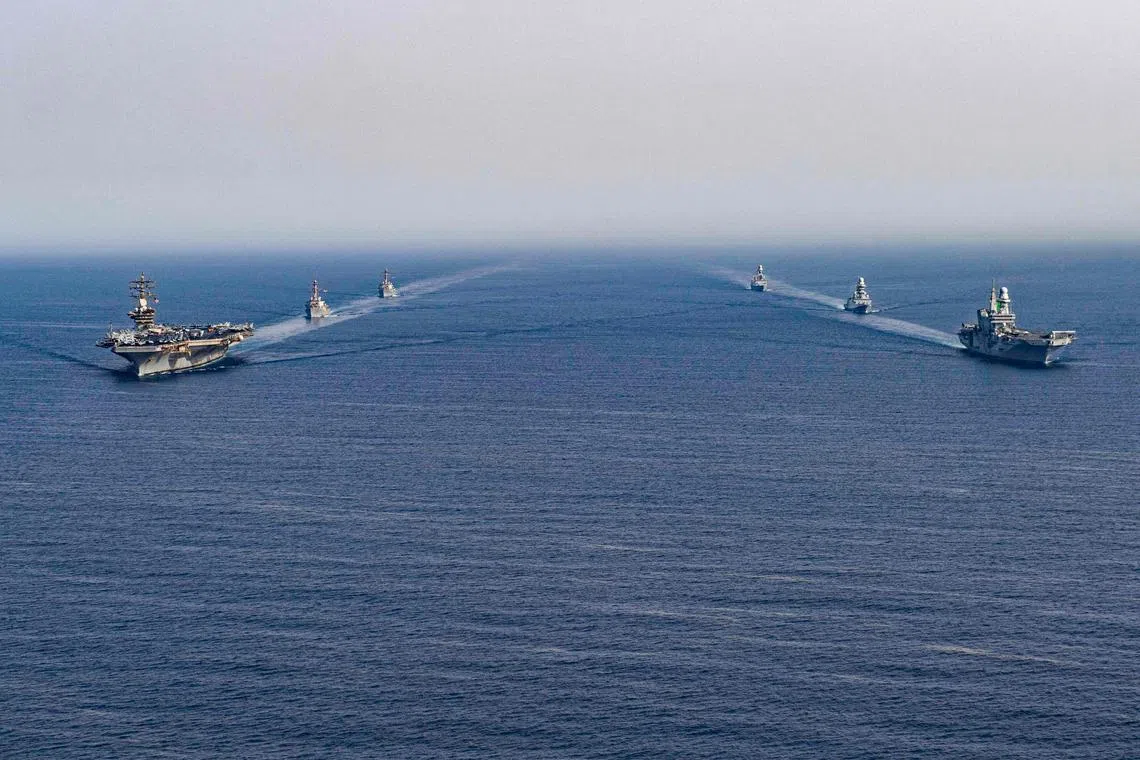Nato steps up naval presence in Western Pacific to counter China
Sign up now: Get insights on Asia's fast-moving developments

Nato now considers China a challenger to its "interests, security and values".
PHOTO: AFP
Follow topic:
BRUSSELS – Nato is bolstering its presence in the Western Pacific by sending warships to more places, a move that risks stoking tensions with China, which is worried about the alliance’s growing influence in the region.
The latest entrant is the Italian aircraft carrier Cavour, the first time Rome has deployed its lone carrier to the Pacific.
The Cavour and an Italian frigate recently held exercises with the US carrier USS Abraham Lincoln near the island of Guam. A day later, F-35 stealth jets and AV-8B Harriers launched from the Cavour practised shooting down airborne targets.
“This is a demonstration, above all, of our ability to project power anywhere,” said Rear-Admiral Giancarlo Ciappina, commander of the Cavour carrier strike group.
Few security analysts expect European navies to play a frontline role in any conflict in the Pacific.
But the rising frequency of their presence is complicating China’s calculus as it raises the tempo of its military activity, including fighter and bomber flights near Taiwan and confrontations with the Philippines in the South China Sea
In times of crisis, European navies might augment the US military, such as by providing additional platforms for US aircraft, adding submarine-hunting capabilities or contributing to supply missions.
Nato members have a mutual defence treaty that only applies to attacks in Europe and North America, so they would not be legally compelled to defend each other in the Indo-Pacific region.
The British aircraft carrier HMS Prince of Wales and its strike group are scheduled to arrive in the Pacific in 2025, and France has said it would send the Charles de Gaulle carrier strike group.
A strike group is a mini-armada built around an aircraft carrier that typically includes destroyers, cruisers and other vessels, as well as fighter jets and other aircraft.
Germany and the Netherlands are among the other members of Nato that plan to send warships to the region.

This handout photo shows the US aircraft carrier Dwight D. Eisenhower and the Italian carrier Cavour sailing in formation in the Red Sea on June 7.
PHOTO: AFP
Nato militaries use standardised equipment and tactics, enabling them to work closely together – known in military jargon as “interoperability”.
In the Pacific, senior officials say the goal is to go further and be able to swop in and out of American and other allied naval battle groups.
“I think, in the future, we have to come more and more to the point where we are not talking any longer about interoperability but where we are talking about interchangeability,” German Chief of Defence General Carsten Breuer said in a recent interview.
Nato had been wary of confrontation with China, but tensions escalated in 2024 when it called Beijing an enabler of Russia’s invasion of Ukraine, an accusation China rejected.
In 2022, Nato included China for the first time in its guiding strategy document, describing the country as a challenger to the organisation’s “interests, security and values”.
China, in turn, says instability is a result of militaries from other regions operating near its shores.
In July, Chinese Foreign Ministry spokesman Lin Jian said Nato should “not create chaos in the Asia-Pacific after creating turmoil in Europe”.
As China’s rhetoric on Nato has aligned with Russia, it has also stepped up military exercises with Moscow, including bomber flights and joint naval patrols.
Military deployments in the Indo-Pacific region by Nato, meanwhile, come as several European countries have adopted national strategies that emphasise their interests in the region, including the continued free flows of trade.
Italy has tried to perform a balancing act with China under Prime Minister Giorgia Meloni. It pulled out of China’s Belt and Road investment initiative in 2023 but Ms Meloni recently visited Beijing and held talks with President Xi Jinping.
After leaving Italy in June, the carrier Cavour took part in multinational military exercises in Australia. It is set to train with the Japanese navy in August before returning home via Singapore and India.
Italy has realised that “engagement without some degree of military power underwriting it, it is simply not enough to signal that one is serious about building ties in an age of growing contestation”, said Professor Alessio Patalano, at King’s College in London.
The emerging role of European navies in the Indo-Pacific comes as demands are increasing on the US military in other locations. The USS Abraham Lincoln was ordered to speed up a planned deployment to the Middle East by the Pentagon after the recent training with the Cavour.
Some security analysts say European navies cannot substitute for a strong US naval presence in the Indo-Pacific, the region the Pentagon has labelled as its priority theatre. Deployments such as the mission to the Middle East for the Abraham Lincoln could stretch the fleet of American carriers.
“This constant demand on carriers means we need 15 of them but we only have 11, placing more stress on the ships and crews. It isn’t sustainable, and the Navy needs to grow to meet the rising dangers,” said Mr Brent Sadler, a senior research fellow at the Heritage Foundation, a Washington-based think-tank.
China has only two operational aircraft carriers but around 234 warships, larger than the US Navy’s total of 219, according to the Centre for Strategic and International Studies, a US think-tank.
China has around half of the world’s shipbuilding capacity, giving it the potential to add to its fleet faster than the US.
Indo-Pacific nations are helping to offset the shortfall, particularly Japan, which has over 100 warships and routinely patrols with the US Navy.
Japan, along with South Korea, Australia and New Zealand, have forged closer ties with Nato, and leaders of the so-called Pacific Four attended the 2024 Nato summit in Washington.
“The security of the Indo-Pacific and the security of the Euro-Atlantic are two sides of the same coin,” said US Ambassador to Japan Rahm Emanuel. “Increased cooperation between Nato member countries and our four Indo-Pacific partners reinforces our collective deterrence and boosts stability across both regions and beyond.” BLOOMBERG

